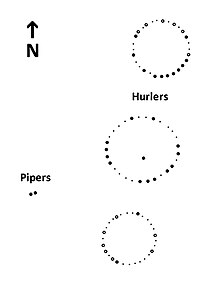The Hurlers
The Hurlers are round stones made of menhirs . You are in the county of Cornwall in England . The megaliths of the cult complex form three stone circles that date from the early Bronze Age .
location
The Hurlers are located in the District Caradon north of Liskeard in the village of Minions at the southern edge of Bodmin Moor in Cornwall. Nearby is Rillaton Barrow and the Trethevy Quoit , a portal tomb from the Neolithic Age . There are other megalithic sites in Cornwall :
- Boskednan stone circle
- Boscawen-ûn
- Chûn Quoit
- Lanyon Quoit
- Mên-an-Tol
- Merry Maidens
- Mulfra Quoit
- Stannon Stone Circle
- Tregeseal stone circle
- Tregiffian
- Zennor Quoit
construction
The three stone circles of the Hurlers, which lie approximately on a line from SSW to NNE, have diameters of 32, 42 and 33 m. The two outer stone settings are circular, while the middle and largest stone circle is slightly elliptical. The southern stone circle is the worst preserved and has only nine of the original 26 monoliths, two of which are upright and the other seven are partially covered with soil. In the middle circle there are still 15 of the 28 stones that were once left, all around 1.8 m high. Some menhirs show clear signs of processing and taper towards the top or have a rounded end. One of the stones was machined so that there was a gap at the top. The northern stone circle consisted of 28 menhirs, of which 11 can still be found upright and 6 lying down.
The Pipers
Two other monoliths, the pipers (bagpipers), stand 120 m southwest of the central circle. They were probably the entrance stones to the cult complex and perhaps also served an astronomical purpose. Due to the lack of dating possibilities, it cannot be determined with certainty whether the stone circles were erected at the same time. The pipers are about 2.0 m high and the distance between them is also about 2.0 m. According to folklore, they represent musicians who play for three circles of dancers who have been turned to stone. The area around the Pipers is known in archeology for the discovery of a bronze dagger and a gold cup, which were found along with some pearls and flint stones in Rillaton Barrow , about 550 m north of the Pipers .
Origin of name
The name The Hurlers goes back to a legend according to which men and women played hurling here on a church holiday and were turned into stones as a punishment. In hurling , two large teams fight with sticks over a wooden ball. The game used to be accompanied by music, which is what the name of the "Pipers" refers to. Also, according to legend, it is hardly possible to determine the exact number of menhirs. Anyone who still manages to count the stones correctly is said to have misfortune.
Research history
The Hurlers and their legend were first discussed in 1586 by William Camden in his topographical and historical account of Britain. As part of another encyclopedic representation of Britain, the description of Cornwall, written by John Norden at the end of the 16th century, in which the menhirs were also mentioned, appeared in 1728. In 1769, William Borlase provided the first detailed archaeological description of the megalithic complex. Hugh O'Neill Hencken wrote a modern scientific account in 1932.
Individual evidence
- ^ William Camden: Britannia , London 1586
- ↑ John North: speculi Britanniae - Cornwall , London 1728
- ^ William Borlase: Antiquities Historical and Monumental of the County of Cornwall , Bowyer and Nichols, London 1769
- ^ Hugh O'Neill Hencken: The Archeology of Cornwall and Scilly , Metheun 1932
literature
- Robin Payne: The Romance of the Stones . Alexander Associates, Fowey 1999, ISBN 1899526218 .
- Ian McNeil Cooke: Standing Stones of the Land's End. An inquiry into their function . Men-an-Tol Studio, Cornwall 1998, ISBN 0951237195 .
- Homer Sykes: Mysterious Britain - Fact and Folklore . Weidenfeld and Nicholson 1993, ISBN 0297831968 , p. 39.
Web links
Coordinates: 50 ° 30 '59.1 " N , 4 ° 27' 28.3" W.




